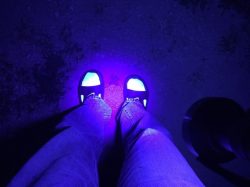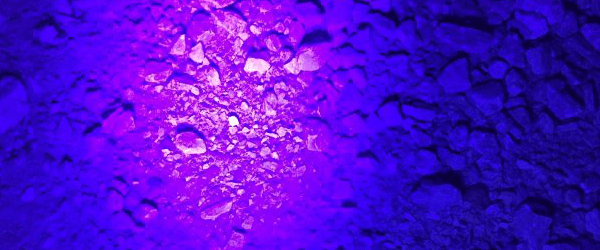Sometimes the hack is a masterwork of circuit design, crafting, 3D printing and programming. Other times, the hack is knowing which tool is right for the job, even when the job isn’t your regular, run-of-the-mill, job. [John]’s son lost his tooth on their gravel driveway, so [John] set out to find it.

When [John] set out to help his son and find the tooth, he needed a plan of attack – there was a large area to cover and, when [John] looked over the expanse of gravel the terms “needle” and “haystack” came to mind. Just scanning the ground wasn’t going to work, he needed a way to differentiate the tooth from the background. Luckily, he had a UV flashlight handy and, after testing it on his own teeth, realized that his son’s tooth would fluoresce under UV light and the gravel wouldn’t.
Off [John] went at night to find the tooth with his flashlight. He soon realized that many things fluoresce under UV light – bits of plastic, quartz crystal in the rocks, his socks. [John] eventually found the tooth, and his son is happier now. No soldering was involved, no development on breadboards, no high-voltage, but this is one of those hacks that is more about problem solving than throwing microcontrollers at a situation. In the end, though, everyone’s happy, and that’s what counts.
















Had a lot of fun with a portable UV light out at night as a kid. Yes indeed there are all sorts of things that fluoresce under UV light that you might not expect including a number of flowers and insects.
scorpions fluoresce under UV light and not dimly either!!!
So do diamonds, I spent a few rainy nights out in the Jupiter Creek goldfields with my 6″ Wood’s glass tube and a rake
Did you end up finding any diamonds?
I know that diamonds fluoresce under Xrays. The tech is used to automatically find diamonds in crushed rock gravel at some mines. I didn’t know they might fluoresce under UV.
lol
nope, but I did get really wet and cold!
I did find a few tiny specks of gold though!
Nice!
My bottom four front teeth are a bridge, and glow blue in flourescent light. It’s pretty disturbing looking.
I’m trying to think of a way of using this story to justify buying a portable tunable laser, because lost teeth and stuff… come on guys help me here!
I’ve been building a small collection of flashlights with different frequency LEDs for related purposes. It would be a cheaper way to gain some of that functionality.
Yes, if those narrow frequencies suited your purpose. Another idea I had was a xenon arc lamp shining into a fibre optic cable and rotatable prism and mask arrangement that you could sweep through the colour values. The bulb, fibre and prism would need to be quartz to get the greatest spectral range.
And with UV activated photoresins he can stick the tooth back in!
Why clothes, especially white and light colors, fluoresce is the “brighteners” in detergents are transparent fluorescent dyes. They react with the UV rays in sunlight to make the cloth appear brighter and more vivid.
I’m missing the hack. Seems he just used a UV flashlight. I remove snow with a shovel — not a hack.
exactly, more like life-hack ….
There it is! I almost thought we wouldn’t have the obligatory not a hack comment.
How about you just click the back button in the future. It’s much quicker and easier….
Thanks for getting my back. I’m the original author and I was just laughing with my brother about what people say in the comments and how harsh they can be in the anonymous internet world.
They work for tomato worms too – they’ll destroy a plant overnight.
Thanks, that’s really worthwhile info, I will check it out. I live in farm/greenhouse country, and should it work, my neighbors thank you.
I wonder if the same happens with other garden pests. I’ll have to experiment next season.
The google suggests that yes, this is common.
https://www.google.com/search?q=insect+fluorescence&rlz=1C1CHBD_enUS691US691&espv=2&biw=964&bih=718&source=lnms&tbm=isch&sa=X&ved=0ahUKEwjM6MDc26HRAhUJRiYKHQj8BbsQ_AUIBigB&dpr=1
I came here bc my grandson lost his first baby tooth in dirt and gravel. I used a black light freaking everything that was white was glowing. I am determined to find this tooth for him. What else should I use as far as a light?
Hello, I used a UV flashlight when I found my son’s tooth, for example this one: https://amzn.to/4juCdE1